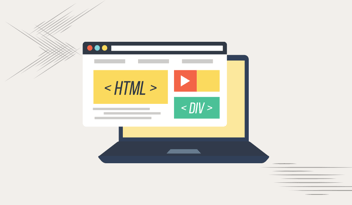
A website’s loading speed is a vital component in search engine ranking and user experience. Every additional second it takes for a webpage to load increases the chance a user will abandon the page. While most marketers understand the importance of optimizing their website’s load times, it is often overlooked or ignored, which can have a significant impact on conversion rates. By understanding what search engines and users expect out of your site speed, you can implement the necessary improvements to boost conversion rates, increase ranking opportunities, and provide a better user experience.
Website load time statistics
To perform well, your website must load quickly enough to satisfy both search engines and end-users. While search engines like Google have general benchmark recommendations in place, end users’ expectations can be even more demanding and influential on the bottom line.
1. 85% of landing pages take longer than 5 seconds to load.
While sites have become substantially faster over the years, the vast majority still fall short of expectations set by Google, which recommends keeping load times under five seconds. Consumers are even less patient, however; the vast majority of users bounce after waiting just three seconds for a page to load.
2. Mobile load speeds are 2.4x slower than desktop load speeds.
Page speed has been a ranking factor for many years, and with Google’s shift to mobile-first indexing, it is even more important to focus on your website’s mobile loading speeds. In 2020, it took mobile pages an average of 11.4 seconds to load, compared to 4.7 seconds for desktop pages. Unfortunately, most mobile pages take longer to load than their desktop counterparts, and mobile users expect pages to load much faster on their mobile devices.
Many marketing practices target users through social media campaigns, which means users are far more likely to encounter these landing pages from their mobile devices. If the page takes too long to load, users will immediately bounce, causing your site to lose out on a large number of potential customers.
3. Improving speed by 0.1 seconds can significantly decrease bounce rates.
Deloitte measured the impact of load times on bounce rates of homepages, product listing pages, and product detail pages on more than 30 million user sessions across multiple industries. A 0.1 second decrease in page speed was correlated with improved bounce rates across all page types and industries, more page views per session, and higher conversion rates.
4. A 1 second delay in load time can cause an 11% decrease in page views.
Google values fast pages, and the faster your site loads, the more likely it is to appear in search results. This load time not only affects bounce rates but also how responsive your website is when search engines crawl it. Search engines allocate a limited amount of time to crawling each site, so the faster your site can respond, the more your pages will be indexed and able to appear in search results.
5. Users visit more pages when a site loads faster.
Platform provider Section found that users visited an average of 5.6 more pages when the average load speed was two seconds compared to eight seconds. For e-commerce sites, this can correlate to more product pages viewed and higher total purchase amounts when users convert.
6. Online shoppers are less likely to make a purchase from a slow site.
The transaction process is one of the most critical moments of the conversion pathway. A survey from Unbounce found that 70% of consumers say page speed influences their willingness to buy. If it takes too long to place an order, many users will simply abandon the process, potentially resulting in a significant loss of sales.
7. Most users prefer adequate page speed over animation and video.
A fast website experience is so important to users that half of them would give up animations and videos on a webpage if it meant the site would load faster. This insight provides a big opportunity for many sites to significantly reduce the size of their website to drastically improve site speeds and provide a better user experience.
How to improve page load time
It's quite clear that site speed has an influence on bounce rates, ranking, and conversion rates. Start improving your website’s loading times by optimizing images, simplifying code, and implementing caching techniques.
1. Optimize images.
Oversized images are one of the leading causes of slow web pages. The larger and higher quality of the image, the more bandwidth it requires to load. Three things you can do to optimize your images include selecting the proper file format, compressing the image size, and using responsive images.
A study run by Match Metrics found that the average website size for desktop and mobile is 1.7-1.9 Mb. Google recommends keeping that size below 0.5 Mb and found that 25% of sites could reduce their site size by over 250 KB simply by compressing their images.
2. Minify JavaScript and CSS files.
When a website has excessive JavaScript and CSS files, it can take longer than necessary to process server requests, especially when browsers send multiple HTTP requests to access the site’s content. Minification removes unnecessary lines and white space from the source code, making the overall size smaller and decreasing the amount of time it takes to read and load the page.
Sites that minify their JavaScript and CSS files often find that there are unnecessary pages, unused plugins, and apps, and duplicated code that causes their site to be much larger than it needs to be.
3. Reduce the use of Flash content.
While Flash content can make the page more interactive and animated, the size of the files can drastically slow down a site’s loading speed. It is best to either minimize these files or remove them all together.
4. Implement caching techniques.
Caching a webpage allows servers to store a page’s HTML file, so the next time a user views the page, the server does not have to go through the process of converting the HTML. Instead, it can skip right to sending the previously prepared file directly to the browser.
5. Use AMP.
Accelerated mobile pages (AMP) are designed to load quickly because they’re stripped down to basic elements. AMP allows pages to use only a subset of HTML and JavaScript elements and sometimes requires techniques such as lazy loading. An optional content delivery network (CDN) automatically caches and implements performance optimizations to AMP-enabled pages.
Focusing on your website speed and page load times does not have to be a daunting task. While site speed is a ranking factor, Google makes frequent updates to its algorithm based on user preferences. Google’s goal is to direct users to websites that will provide the best experience for users. Optimizing your site to better serve your users by loading faster can help you attain higher conversion rates, lower bounce rates, and greater customer satisfaction.


